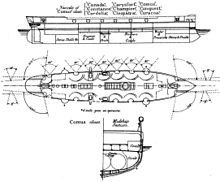HMS Curacoa (1878)
 HMS Curacoa drydocked in Sydney Harbour c.1890.
| |
| History | |
|---|---|
| Name | Curacoa |
| Builder | John Elder & Co., Govan |
| Yard number | 210 |
| Launched | 18 April 1878 |
| Fate | Sold 1904 for breaking up. |
| General characteristics | |
| Class and type | Template:Sclass- |
| Displacement | 2,380 tons |
| Length | 225 ft (69 m) |
| Beam | 44 ft (13 m) |
| Draught | 19 ft (6 m) |
| Propulsion | Single screw driven by compound engines of 2,590 ihp ( MW) |
| Sail plan | Barque or ship rig |
| Speed | 13.75 kt (25.5 km/h) powered; 14.75 kt (27.3 km/h) |
| Armament |
|
| Armour | Deck: 1.5 in (38 mm) over engines |
HMS Curacoa was an Template:Sclass- of the Royal Navy, built by John Elder & Co., Govan and launched on 18 April 1878.[2]
The corvette commenced service on the Cape of Good Hope and West Africa Station before being transferred to the Australia Station arriving on 5 August 1890. She left the Australia Station in December 1894.[2]
Recently discovered log books from descendants of Mr.(Cptn) J.P. Shipton, record the journey to Australia. Daily logs show Curacoa leaving port in the UK on 1 April 1889, with stops at Perth, Albany, Adelaide, Launceston, Melbourne, Sydney, Wellington, Auckland, Christchurch / Lyttleton, and the final entry shows 31 December 1890, in port at Lyttleton (near Christchurch), New Zealand.
Curacoa was sent to the Ellice Islands and between 9 and 16 October 1892 Captain Gibson visited each of the islands to make a formal declaration that the islands were to be a British Protectorate.[3] In June 1893 Captain Gibson visited the southern Solomon islands and made the formal declaration of the British Solomon Islands Protectorate.[4]
Her later years were spent as a training cruiser. In February 1900 she visited Madeira, Commander Herbert Lyon in command.[5]
She was sold in May 1904 to King of Garston for breaking up.[2]

Citations
- ^ Winfield (2004) p.272
- ^ a b c Bastock, p.107.
- ^ Noatia P. Teo, Hugh Larcy (ed) (1983). "Chapter 17, Colonial Rule". Tuvalu: A History. University of the South Pacific/Government of Tuvalu. pp. 127–139.
{{cite book}}:|last1=has generic name (help); Cite has empty unknown parameter:|chapterurl=(help) - ^ Commonwealth and Colonial Law by Kenneth Roberts-Wray, London, Stevens, 1966. P. 897
- ^ "Naval & Military intelligence". The Times. No. 36056. London. 3 February 1900. p. 14. template uses deprecated parameter(s) (help)
References
- Bastock, John (1988), Ships on the Australia Station, Child & Associates Publishing Pty Ltd; Frenchs Forest, Australia. ISBN 0-86777-348-0
- Winfield, R.; Lyon, D. (2004). The Sail and Steam Navy List: All the Ships of the Royal Navy 1815–1889. London: Chatham Publishing. ISBN 978-1-86176-032-6. OCLC 52620555.
External links
